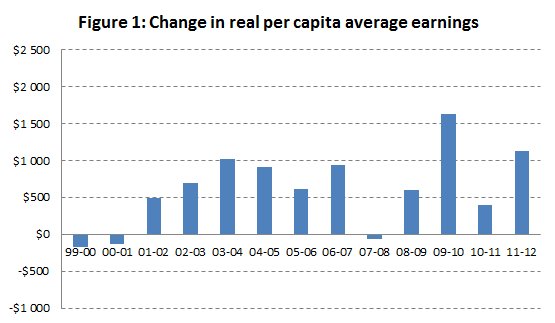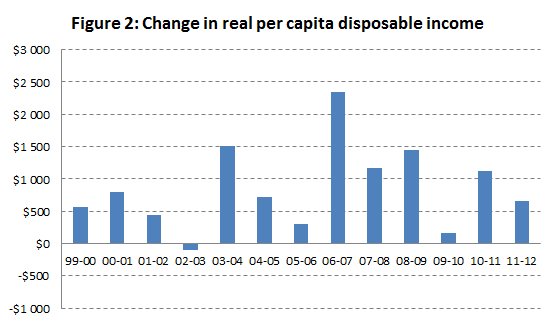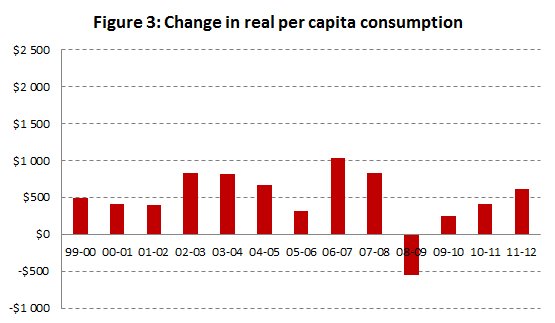In case you missed it in last Sunday’s leaders’ debate, both Tony Abbott and Kevin Rudd talked about cost-of-living pressures.
From Abbott we heard: “Who can ease your cost-of-living pressures?” and “I’ve got to say that as far as an incoming Coalition Government is concerned, the priority will be on things like reducing cost-of-living pressure and job security.”
Rudd was a little more definite when he said: “We believe that families across Australia are under significant cost-of-living pressures.”
We all know we’re doing it tough, don’t we? But when we look for evidence to support the idea that we are suffering a cost-of-living squeeze, it’s hard to find.
Of course everyone, apart from the extremely rich and those who have taken a vow of poverty, can be said to face “cost-of-living pressures” – that’s the nature of economic life – but have those pressures intensified over recent years?
The usual way of measuring material living standards is to look at incomes in “real” – that is, inflation-adjusted – terms. If our incomes are not keeping up with inflation our “real” incomes are falling, and we are indeed feeling increased cost-of-living pressures.
When we look at Australians’ wages and salaries the general story is of strong growth over this century. By 2012 real average annual earnings were about $8000 a year higher (in 2012 dollars) than they were in 2000. In recent years only in 2007-08, the year of the global financial crisis (GFC), did average earnings fall a tad – about $70 a year – before resuming their strong growth, as shown below.

These figures do not fully reflect our general situation, however, because they are based on people’s pay packets. We get a slightly more complete picture from looking at disposable income – that is, what we have to spend after income taxes, social security benefits and payments such as dividends are taken into account.

Again, they show the same strong growth, stronger in fact than average wages and salaries, mainly because there has been a steady fall in unemployment over this century. In the wake of the GFC unemployment peaked at 5.8 per cent, and is again heading up a little, but at the turn of the century it had been 6.6 per cent.
What the figures do show, however, is a big jump in incomes in 2006-07, when the Howard government went on a spendathon before the 2007 election. The GFC didn’t show an immediate downturn, presumably because of the Rudd Government’s timely fiscal response, but in 2009-10, as the Government withdrew stimulus spending, disposable incomes hardly rose. They have been rising healthily since.
These are all average figures and we know that some people are doing better than others. Those whose incomes are tied only to inflation, such as people on Newstart allowances and some retired public servants, have not seen their real incomes rise, nor have those whose circumstances require above-average use of some items with rapidly rising prices, such as people with chronic illnesses.
But because those groups are in a minority, for the majority real incomes would be rising even faster than as revealed by average figures. (For detailed analysis see a research project I completed last year for the Centre for Policy Development, and a slightly earlier research project by Per Capita.)
So is there some explanation for this difference between perception and reality? I suggest six reasons, all somewhat speculative (establishing causes for perceptions is tricky), but all plausible.
First, is the political beat up. The Coalition and the Murdoch press have missed no opportunity to add to the din of complaint, particularly in relation to the carbon tax. The Government too bears some responsibility, because, rather than engaging with the community in a mature way, it has embraced the rhetoric about cost-of-living pressures, presumably in an attempt to show empathy with “battlers”. Rudd’s promise to make an early move to an emissions trading scheme is virtually an admission that the carbon tax has been a big burden on households, although this is not the case.
Second, a well-known finding of behavioural economics is that we feel the pain of a loss more strongly than the pleasure of a gain. Prices are moving around – some, such as health care and utilities up, some, such as telecommunications and clothing down. In our consciousness those rises register more strongly than offsetting falls.
Third, we get frequent reminders of some price rises. They grab our attention. For example, the real cost of driving a car has been falling for many years, mainly because cars have been getting cheaper, easily offsetting higher fuel prices. But we don’t buy cars very often, while we may buy fuel a few times each month. Similarly, while we replace our electrical appliances only every 10 years or so, our electricity bills come quarterly, and we often fail to distinguish between price effects and our own changing consumption.
Fourth, our norms of what we consider to be reasonable standards of consumption shift. For example, in 2000 only 32 per cent of Australians held private health insurance; the figure is now 47 per cent. More families are sending their children to private schools. More generally, there is the influence of advertising, tempting us with goods that always seem to be just beyond our reach. And there is the vulgar behaviour that Thorstein Veblen a century ago called “conspicuous consumption” to show off one’s personal success. (Remember, however, that when you see a $160,000 BMW 550i on the road that it has probably been subsidised by taxpayers under FBT concessions.)
Fifth, as I explained earlier this week, because of low inflation the burden of mortgage repayments is hanging around a little longer than we had hoped – a point also taken up by John Quiggin in Crikey on Thursday.
Sixth, and perhaps the strongest influence, is that after a decade of easy spending, fuelled by the illusion that rising house prices constituted real increases in wealth, we have become more cautious. Perhaps we judge our material wellbeing not by what’s available to spend, but by what we actually spend. In response to the GFC we stopped spending and started saving again as we had before the turn of the century. A $500 drop in spending in one year does not sound much, but for most people this saving would have been made from a comparatively small amount of uncommitted or discretionary income.

We know how this restoration of thrift has affected retailers, and the Government knows that it’s one reason why fiscal and monetary stimuli have not been as effective as hoped. Just why it has occurred is less clear. Possibly people have become more realistic about their house valuations, which in some cities are stalling in nominal terms therefore falling in real terms. Indicators of consumer confidence took a dive at the time of the GFC, and made an equally sharp recovery just afterwards, before settling back to around their long-term average, which means our consumption should by now be back to normal. Perhaps the new normal, after a decade of debt-financed consumption, is personal prudence.
Whatever the reason, we are adept at complaining, and, thanks to the political climate fuelled by the Opposition’s tactic of blaming every imagined or real adversity on the Government, “cost-of-living” will be a strong theme up to election day.
Beyond then? If we can wail this loudly when we’re doing well, how will we react when falling exchange rates and cuts in public expenditure really do start squeezing our material living standards?
Donate To New Matilda
New Matilda is a small, independent media outlet. We survive through reader contributions, and never losing a lawsuit. If you got something from this article, giving something back helps us to continue speaking truth to power. Every little bit counts.



